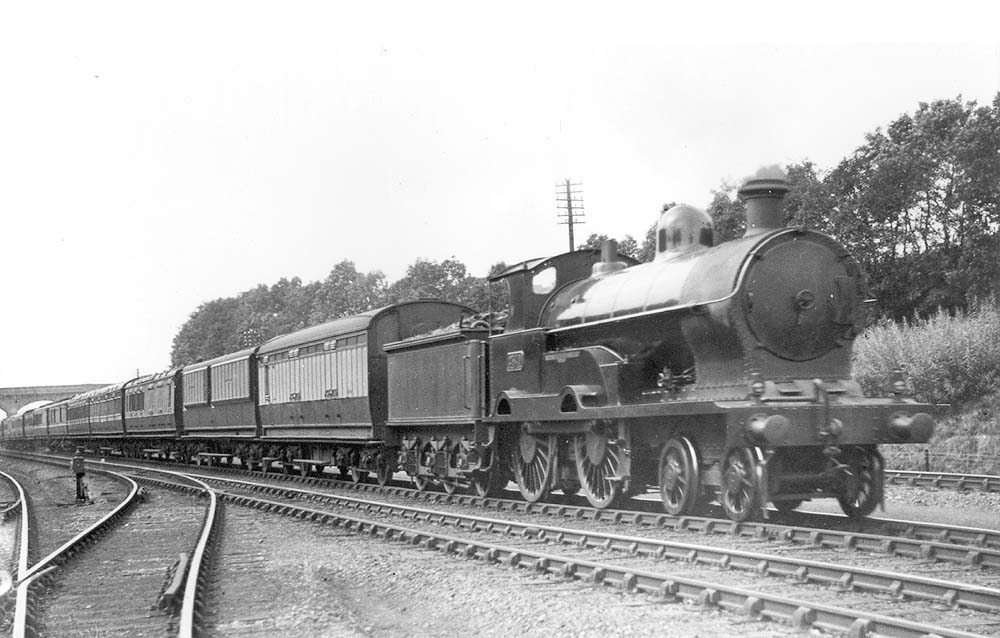LMS Route: Trent Valley Line
Shilton Station: lnwr_shil1231
 |
An unidentified LNWR 4-4-0 George Fifth class locomotive is
seen a down express near Shilton station circa 1919-22. John Stockton-Wood
and Philip A. Millard wrote in the article in LNWR Society Journal Volume 5
No 8 Page 36 'The History and Make Up of the Irish Mail, The Earliest Named
Train in the World' 'The first vehicle is one of the two 50ft 0in high roof
end-guard brake vans to D 372 used exclusively on the Irish mail trains'. First
vehicle is 42ft 0in x 8ft 6in brake van D 382, one of 165 built 1911 - 24. The
first 25 were gas lit, the remainder (as here) were electric. Second vehicle is
50ft 0in Post Office No 9536 of D 392. This vehicle was built specially for the
5.15 am Euston-Crewe Day Mail service and had a number of differences compared
with the others of D 392, as it was fitted with a flush rather than recessed
receiving net which involved alterations to the panelling in that area. Unlike
the others, the letter and newspaper sets on the offside did not run the full
length of the vehicle as there was an extra 3ft 3in hinged door fitted at the
rear end as well as the normal 2ft 3in door placed centrally.
The Day Mail service ceased to run on 30th March 1918 and
thereafter this carriage was employed on the Irish Mail. On 29th February 1928
it was involved in an accident at Euston when the up Day Irish Mail entered No
1 platform line at excessive speed and collided heavily with the buffer stops.
No 36, now running as LMS 3232, was very badly damaged and the body was lifted
from the underframe. A number of Post Office workers, but no passengers, were
injured. The carriage was repaired and remained on the same service until 1937
when, along with the other TPOs of LNWR origin, it was displaced by new
LMS-built TPOs and became a spare vehicle at Carlisle for the Edinburgh
service. The third vehicle is a 57ft 0in x 9ft 0in BTK to D 310.
The LNWR 'George V' Class was introduced in 1910 by Charles
Bowen-Cooke with construction continued until 1915. They were essentially a
superheated version of the LNWR 4-4-0 Precursor Class designed by George Whale.
At the same time, similar non-superheated Queen Mary Class engines were also
built but all of these acquired superheaters as the advantages of superheating
became clear and were absorbed into the George the Fifth Class. A total of 90
Georges were built and all were named with the LNWR reusing names and numbers
from withdrawn locomotives resulting in the numbering system being completely
haphazard. All of the George V's passed into London Midland and Scottish
Railway (LMS) ownership on the grouping in 1923. The LMS gave them the power
classification 3P.
The LMS renumbered them into a more logical series of
5320-409, and later in 1936-7 those had not been then withdrawn were again
renumbered by the addition of 20000 into the 25320-409 series to make room for
Black Fives. Also at this time a few of the names were removed so that they
could be applied to new LMS Jubilee Class engines. Withdrawals started in 1935,
and by 1939 only 9 remained. British Railways (BR) inherited 3 in 1948; No
25321, which was withdrawn in February that year, and Nos 25350 and 25373,
which were allocated the BR numbers 58011 and 58012 but never carried them as
both were withdrawn in May the same year.
An original photograph by Henry L Salmon
 back back

|
